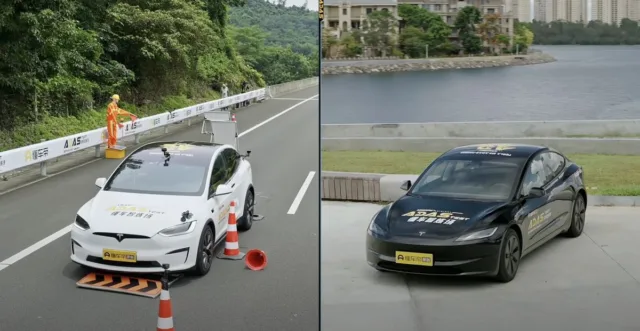
Tesla outperformed all major Chinese electric vehicle makers in a comprehensive highway driver-assistance test conducted by the local media Dongchedi.
The test evaluated 36 mass-market models across six simulated high-speed accident scenarios designed to mimic common but dangerous events on Chinese highways, such as stalled vehicles, merging trucks from construction zones, sudden braking inside tunnels, and congestion after highway on-ramps.
Each scenario measured the performance of vehicles equipped with Navigate on Autopilot (NOA) or similar systems, along with emergency braking (AEB) functions.
Tesla’s Model 3 and Model X ranked as the top performers, each successfully passing five out of six test scenarios.
Although all the Chinese EVs tested were from 2024 or 2025 model years, both Tesla vehicles tested were from the 2023 model year.
The Model 3 was a rear-wheel drive version, while the Model X featured a dual-motor all-wheel drive configuration.
The vehicles consistently identified and avoided hazards across most scenarios, including emergency responses in construction lanes and in situations where the lead vehicle suddenly disappeared or decelerated sharply.
All the other brands tested — including Xiaomi, XPeng, Nio, Aito, Li Auto and many others — failed at least three of the six scenarios.
In contrast, Chinese brands underperformed, with many models either failing to respond appropriately or missing key hazards entirely.
Nio’s 2025 ES6 SUV passed only one of four test scenarios, while its budget-focused Firefly model failed all four cases it was tested in.
Zeekr’s 001, Xpeng’s P7+, BYD’s Song Plus DM-i, and Avatr’s 12 also posted disappointing results, failing all or nearly all scenarios.
Dongchedi noted that the Xpeng G6, Li Auto L9, and the Huawei-backed Avatr 11 managed partial success, each passing three of six scenarios.
However, even these higher-scoring Chinese models fell short of Tesla’s performance, particularly in reacting to hidden or partially obscured objects on the road.
The testing framework simulated six distinct highway accident scenarios that included a stationary vehicle in the travel lane, a large truck merging from a construction site, sudden deceleration inside a tunnel, a lead vehicle suddenly disappearing behind another car, congestion immediately after a highway entrance, and a pedestrian appearing on a multilane highway.
Dongchedi emphasized that results may vary across different vehicle trims and software versions, but the outcomes nevertheless paint a stark picture of the current gap between Tesla and its Chinese counterparts in the area of automated safety.
Of the 36 vehicles tested, 16 models failed all or nearly all scenarios. Some failed to activate AEB or NOA at all, while others provided insufficient warnings or late responses.
Tesla is preparing to launch a new version of its Model 3 sedan in China, the vehicle with the longest range of any Tesla vehicle sold in the country.
Although Tesla officially teased the new 6-seater Model Y on Chinese social media, the company did not comment or promote the new trim of the Model 3. The Model Y is coming “this Fall.”
The Model 3 posted 16,636 retail sales in June, according to industry data — up 20% from May but down more than 8% from the prior year, marking the second straight month of annual decline.








